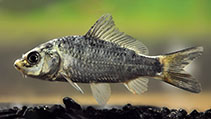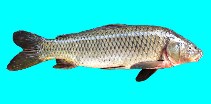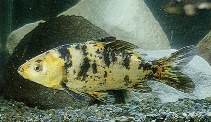Germany country information
Common names:
Donaukarpfe, Flußgründling, Karpe
Occurrence: introduced
Salinity: freshwater
Abundance: common (usually seen) | Ref: Winkler, H.M., K. Skora, R. Repecka, M. Ploks, A. Neelov, L. Urho, A. Gushin and H. Jespersen, 2000
Importance: commercial | Ref:
Aquaculture: commercial | Ref: FAO, 1997
Regulations: | Ref:
Uses: no uses
Comments: Rare and not reproducing in the Neckar (Ref. 10013). If there ever was a wild form in Germany, it is considered critically endangered in 1984 (Ref. 27368). Also Ref. 1672, 3137, 648.
National Checklist:
Country Information: https://www.cia.gov/library/publications/resources/the-world-factbook/geos/gm.html
National Fisheries Authority: http://www.ble.de/index.cfm?8C712107D9244972B3C193AC1917DCE7#Handelsbezeichnungen
Occurrences: Occurrences Point map
Main Ref: Welcomme, R.L., 1988
National Database: AGRDEU
Occurrence: introduced
Salinity: freshwater
Abundance: common (usually seen) | Ref: Winkler, H.M., K. Skora, R. Repecka, M. Ploks, A. Neelov, L. Urho, A. Gushin and H. Jespersen, 2000
Importance: commercial | Ref:
Aquaculture: commercial | Ref: FAO, 1997
Regulations: | Ref:
Uses: no uses
Comments: Rare and not reproducing in the Neckar (Ref. 10013). If there ever was a wild form in Germany, it is considered critically endangered in 1984 (Ref. 27368). Also Ref. 1672, 3137, 648.
National Checklist:
Country Information: https://www.cia.gov/library/publications/resources/the-world-factbook/geos/gm.html
National Fisheries Authority: http://www.ble.de/index.cfm?8C712107D9244972B3C193AC1917DCE7#Handelsbezeichnungen
Occurrences: Occurrences Point map
Main Ref: Welcomme, R.L., 1988
National Database: AGRDEU
Common names from other countries
分類 / Names 共通名の | 類義語 | Catalog of Fishes(部類, 種) | ITIS | CoL | WoRMS | Cloffa
> Cypriniformes (Carps) > Cyprinidae (Minnows or carps) > Cyprininae
Etymology: Cyprinus: Latin, cyprinus = carp (Ref. 45335); carpio: carpio is the latinized form of carp (Ref. 1998). Cyprinus is the old world name for the carp (Ref. 10294).
More on author: Linnaeus.
Etymology: Cyprinus: Latin, cyprinus = carp (Ref. 45335); carpio: carpio is the latinized form of carp (Ref. 1998). Cyprinus is the old world name for the carp (Ref. 10294).
More on author: Linnaeus.
Environment: milieu / climate zone / depth range / distribution range 生態学
; 新鮮な水; 汽水性の 底生の漂泳性; pH range: 6.5 - 9.0; dH range: 10 - 15; potamodromous (Ref. 51243); 深さの範囲 0 - 29 m (Ref. 120823). Subtropical; 3°C - 35°C (Ref. 12741); 54°N - 34°N, 12°E - 74°E (Ref. 59043)
分布 国々 | 国連食糧農業機関の区域 | エコシステム | 事件 | Point map | 導入 | Faunafri
Europe to Asia: Black, Caspian and Aral Sea basins. Introduced throughout the world. Wild stocks are only present naturally in rivers draining to the Black, Caspian and Aral Sea (Ref. 59043). A reophilic wild population in the Danube is assumed to be the origin of the European species; this population is now under threat (Ref. 13696).
Length at first maturity / サイズ / 重さ / 年齢
Maturity: Lm 34.8, range 25 - 36 cm
Max length : 120 cm TL オス/雌雄の選別がない; (Ref. 27549); common length : 31.0 cm TL オス/雌雄の選別がない; (Ref. 3561); 最大公表体重: 40.1 kg (Ref. 72380); 最大記録サイズ: 38 年 (Ref. 72479)
Max length : 120 cm TL オス/雌雄の選別がない; (Ref. 27549); common length : 31.0 cm TL オス/雌雄の選別がない; (Ref. 3561); 最大公表体重: 40.1 kg (Ref. 72380); 最大記録サイズ: 38 年 (Ref. 72479)
簡単な記述 検索表 | 形態学 | 形態計測学
背面の脊椎 (合計) : 3 - 4; 背鰭 (合計) : 17 - 23; 肛門の骨: 2 - 3; 臀鰭: 5 - 6; 脊つい: 36 - 37. Diagnosed from other cyprinid species in Europe by having the following characters: 2 pairs of barbels; dorsal fin with 15-20½ branched rays; caudal fin deeply emarginate (Ref. 59043). Pharyngeal teeth 1, 1, 3:3, 1,1, robust, molar-like with crown flattened or somewhat furrowed. Scales large and thick. `Wild carp ' is generally distinguished by its less stocky build with height of body 1:3.2-4.8 in standard length. Very variable in form, proportions, squamation, development of fins, and color. Caudal fin with 3 spines and 17-19 rays (Ref. 2196). Last simple anal ray bony and serrated posteriorly; 4 barbels; 17-20 branched dorsal rays; body grey to bronze (Ref. 43281). Also Ref. 3398, 3410.
Inhabits warm, deep, slow-flowing and still waters such as lowland rivers and large, well vegetated lakes (Ref. 59043). Hardy and tolerant of a wide variety of conditions but generally favor large water bodies with slow flowing or standing water and soft bottom sediments. Thrive in large turbid rivers (Ref. 1998). Most active at dusk and dawn. Both adults and juveniles feed on a variety of benthic organisms and plant material. Breeds along shores or in backwaters. Adults often undertake considerable spawning migration to suitable backwaters and flooded meadows. Larvae survive only in very warm water among shallow submerged vegetation (Ref. 59043). Occurs at depths of <30m (Ref. 120613) and found sucking in floating insects at the surface (Ref. 120823). River regulation and hybridization with domesticated stocks, East Asian congeners and their hybrids have caused continuous decline of wild populations (Ref. 59043). Utilized fresh and frozen (Ref. 9987). Aquarium keeping: in groups of 5 or more individuals; minimum aquarium size >200 cm; not recommended for home aquariums (Ref. 51539).
Life cycle and mating behavior 成熟 | 繁殖 | 放精 | 卵 | 生産力 | 幼生
Spawn in marginal, shallow, weed-infested areas. A polytypic plastic species with a marked tendency to produce `varieties' and `races' in response to selective breeding and environmental influences. Carp is polygamous. A spawning female is usually followed by several males. Under tropical conditions carp breeds throughout the year. It is a seasonal spawner in temperate waters (Ref. 185). Females are known to lay more than a million eggs in a season; breeds at a temperature range of 15° C to 20°C; eggs hatch in 4 days (Ref. 6028). Obligatory plant spawners (Ref. 7471). "Adults often make considerable spawning migrations to suitable backwaters and flooded meadows. Individual females spawn with a few males in dense vegetation. The sticky eggs are attached to water plants or other submerged objects. Reproductive success is restricted to years when the water level starts rising in May and when high temperatures and flooding of terrestrial vegetation last for a long period during May and June" (Ref. 59043).
主な参考文献
Upload your references | 参考文献 | コーディネーター | 協力者
Kottelat, M. and J. Freyhof, 2007. Handbook of European freshwater fishes. Publications Kottelat, Cornol and Freyhof, Berlin. 646 pp. (Ref. 59043)
IUCNのレッドリストの状況は (Ref. 130435: Version 2024-2)
軽度懸念 (LC) (Least Concern); Date assessed: 09 June 2022
人間に対する脅威
Potential pest
Human uses
水産業: 高い商業の; 水産養殖: 商業; ゲームフィッシュ: はい; 水族館・水槽: 商業
より多くの情報
Population dynamics
成長のパラメーター
Max. ages / sizes
Length-weight rel.
Length-length rel.
体長組成
Mass conversion
補充
豊度
成長のパラメーター
Max. ages / sizes
Length-weight rel.
Length-length rel.
体長組成
Mass conversion
補充
豊度
Physiology
Body composition
Nutrients
酸素消費
水泳形態
泳ぐ速さ
Visual pigments
Fish sound
Diseases & Parasites
Toxicity (LC50s)
Body composition
Nutrients
酸素消費
水泳形態
泳ぐ速さ
Visual pigments
Fish sound
Diseases & Parasites
Toxicity (LC50s)
用具
Bio-Quiz | E-book | 野外観察図鑑 | 検索表 | Length-frequency wizard | 生活史の基盤ツール | 目的のマップ | Classification Tree
| Catch-MSY |
特記事項
XMLをダウンロードして下さい
インターネットの情報源
Alien/Invasive Species database | Aquatic Commons | BHL | Cloffa | BOLDSystems | Websites from users | Check FishWatcher | CISTI | Catalog of Fishes(部類, 種) | DiscoverLife | DORIS | ECOTOX | Faunafri | Fishtrace | GenBank(ゲノム, ヌクレオチド) | GloBI | GOBASE | | Google Books | Google Scholar | Google | IGFA World Record | MitoFish | 国のデーターベース | Otolith Atlas of Taiwan Fishes | 公共の水族館 | PubMed | Reef Life Survey | Scirus | SeaLifeBase | 生命の木 | Wikipedia(行く, 検索する) | World Records Freshwater Fishing | Zoobank | 動物に関する記録
Estimates based on models
Phylogenetic diversity index (Ref. 82804): PD50 = 0.5000 [Uniqueness, from 0.5 = low to 2.0 = high].
Bayesian length-weight: a=0.01778 (0.01629 - 0.01941), b=2.95 (2.92 - 2.98), in cm Total Length, based on LWR estimates for this species (Ref. 93245).
栄養段階 (Ref. 69278): 3.1 ±0.0 se; based on diet studies.
回復力 (Ref. 120179): 手段, 1.4年~4.4年の倍増期間の最小個体群 (K=0.10-0.30; tm=1-3; tmax=20; Fec=36,000-2,000,000).
Fishing Vulnerability (Ref. 59153): High vulnerability (60 of 100).






